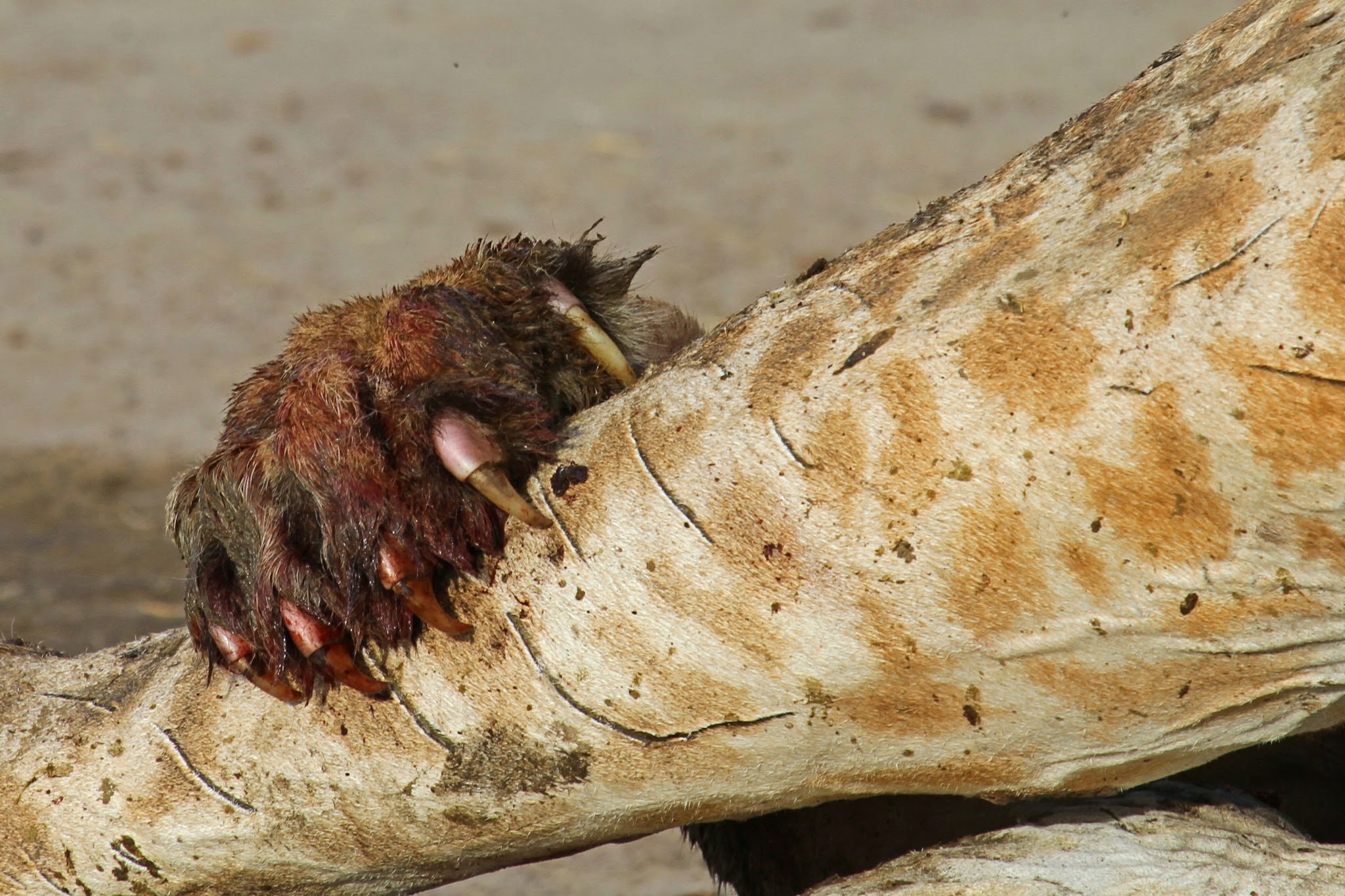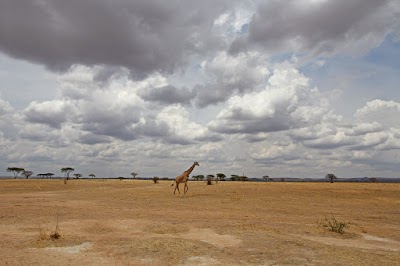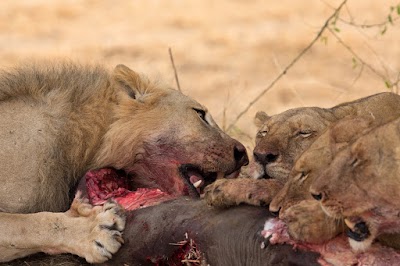Ruaha, kingdom of the lions

“They really seem to appear out of nowhere, these lion prides!”
Our love for Ruaha began in 2011 when we visited the park for the first time. We spent 3 nights in Ruaha combined with a visit to the Selous Game Reserve, and we were already captivated by the park and the abundant wildlife in the area.
This time, we decided to spend a full week in the park to spot as much wildlife and predators as possible! We chose to travel again at the end of the dry season, as most of the wildlife tends to concentrate around the few remaining water sources, namely the Mwagusi and Ruaha rivers, which usually guarantee spectacular sightings!
Together with the people from Matoke Tours, we searched for the best possible camp that could serve as our base for our stay in Ruaha, an area as large as Belgium. Eventually, we settled on Mdonya Old River Camp due to its ideal location, close to the Mwagusi River and the Ruaha River.
We flew to Tanzania with Swissair with layovers in Zurich and Nairobi. On Saturday night around 10:30 PM, we landed in Dar-Es-Salaam, where we stayed at the Slipway Hotel, located on the bay of Dar-Es-Salaam.
**DAY 1**
The next morning, we departed from Dar-Es-Salaam’s airport on a “bush” plane bound for Ruaha National Park. After a flight of just under 2 hours, we landed at Ruaha National Park’s airstrip. We met our guide, Christian, and driver, Ayoub, and prepared for an hour-long journey to our camp, cameras and binoculars at the ready. After about half an hour of driving, we immediately encountered a lion pride – the Mbagi pride according to our guide – consisting of about ten lions who appeared quite hungry and were exploring the surroundings. We were immediately on high alert and asked our guide to stay with the lion pride. After some time, when our lions spotted a herd of buffaloes, we decided to skip our lunch and the associated drive to the camp and instead stayed with the lion group in the hope of witnessing a spectacular charge. The lion pride settled about 100 meters away from the buffalo herd and kept a close eye on them. As evening fell, one of the young lions in the group couldn’t wait any longer and headed toward the buffalo herd, hoping that its companions would follow suit. However, none of the group members reacted, leaving the young lion to fend for itself. The buffaloes noticed the lion and made it clear that they were not pleased with its presence. With its tail between its legs, the young lion returned to the company of its fellow lions. This signaled to us that it was time to head back to the camp. In the camp, we enjoyed a delicious meal in the evening. What a start to our safari!
**DAY 2**
Feeling refreshed, we set out again at dawn to the place where we had left the Mbagi pride the day before. However, this time, we found only one lioness – according to our guide, also a member of the same group – lying in ambush, ready to pounce on one of the impalas grazing in the dried-up Mwagusi riverbed. Once again, we asked our guide to stay with the lioness in the hope of witnessing a spectacular attack.
Hours passed, and after the impala herd, a family of kudus passed by, as did a herd of buffaloes, but our lioness didn’t budge. Eventually, we left the lioness where she was and continued our journey. Our disappointment vanished when our driver, Ayoub, spotted a leopard resting in a tree. It was impressive how our driver spotted it from such a distance – I estimate about 600 meters! After spending some time with the leopard, we stopped by the banks of the Mwagusi River to enjoy a delicious bush lunch. To our surprise, we were not served a cardboard box with a few sandwiches but a real lunch buffet with tasty pasta, vegetables, and cooked meat. We had never been served such a delicious bush lunch before. You could literally taste the Italian roots of the camp owners. After our lunch, we explored a new area where we saw a succession of elephants resting in the shade of a tree, giraffes, and bateleur eagles circling in the sky. On the way back to the camp, our guides took us to a place where we encountered the Mdonya Juu lion pride resting in a riverbed, accompanied by some cubs.
**DAY 3**
On the third day, we chose to go on a full-day game drive once again and headed to the lion pride Mdonya Juu before sunrise, hoping to photograph the cubs in better sunlight. On the way, we were treated to a pair of bat-eared foxes who posed undisturbed for our lenses. After an hour’s drive, we arrived at our destination. We immediately saw three cubs taking their first steps in the beautiful morning sun. According to our guide, two of the three cubs were not even three months old. We spent about an hour with this cheerful bunch before setting off in search of the Mbagi lion pride, knowing that these lions would make a “kill” sooner or later, something we didn’t want to miss for anything.
On our way, we had to navigate through a herd of buffaloes and stumbled upon a new lion pride, the Bushbock pride. It was incredible how many lions lived in such a relatively small area. The Bushbock pride consisted of three lionesses and one lion. We stayed with them for a while and witnessed them one by one going to drink from one of the few remaining pools in the Ruaha Riverbed. After an hour, we continued our journey, but after a few minutes, we encountered another lion pride, the Njaa pride, resting in the shade of a majestic baobab tree. They truly seemed to appear out of nowhere, these lion prides! Finally, in the evening, we found what we were looking for: the Mbagi pride. This time, they had just brought down a giraffe! According to our guide, the giraffe had been dead for only about fifteen minutes. What followed was a three-hour spectacle, a photographer’s dream! Each lion took its turn at the feast, indulging in the giraffe.
**Day 4:**
After a short night, where we were also awakened by the visit of a noisy lion pride to our camp, we were up very early, ready by our jeep to head back to the Mbagi pride. We were eager to find out what was left of the giraffe and whether we’d encounter jackals and hyenas. Upon arrival, it was immediately clear that not much of the giraffe remained. Apart from a lone jackal, there were no hyenas to be seen. After an hour, we left the Mbagi pride behind and decided to explore the banks of the Ruaha River. It was an incredibly hot day, and we had to constantly battle the overly enthusiastic tsetse flies. Fortunately, our guides burned some elephant dung to smoke the flies away from us. We encountered an elephant herd that clearly wasn’t thrilled about our presence and the Bushbock pride, seeking rest and shade. Just before our return to camp, we stumbled upon a new lion pride – the Msembe pride – which had just taken down a baby elephant. What followed was a feast for our eyes and ears. The Msembe pride, consisting of two lionesses and a lion, devoured the baby elephant before us, as if it were their last meal, while on the horizon, the mother elephant wandered aimlessly in search of her little one. We witnessed a feast where every member of the pride fought for their piece of baby elephant meat.
**Day 5:**
Today, we decided to head down to the Jongomero region. We hadn’t seen any wild dogs yet, and since we’re both huge fans of this breed, we wanted to take a chance to find them in an area where they are regularly seen. Even the prospect of possibly being overwhelmed by annoying and relentless tsetse flies didn’t deter us. With a large amount of smoldering elephant dung in our wake, light-colored clothing, a fly swatter, and plenty of optimism, we set off for the Jongomero region, ready to meet our favorite friends. Along the way, we were immediately treated to a unique sighting, sable antelopes. If this was a preview of things to come, it promised much good. After about 3 hours of driving, we arrived in a “Marsh” environment, a place where wild dogs like to hang out. However, we also noticed that this was a tsetse fly area. Our jeep was literally invaded by tsetse flies of a size we had never seen before. Some of these flies were up to 5 centimeters long. Terrible! Fortunately, we had an Australian anti-tsetse fly product (RID repellent) that prevented the flies from landing on us but on the canvas of our jeep instead. It wasn’t pleasant, but we had to endure it. Amidst the buzzing of flies, we tried to search for wild dogs. But after several hours of driving in scorching heat without seeing a single dog, let alone other animals, we decided to head back. On the way, our guides made a brief stop at a hot spring, where they washed their hands, believing it brought luck according to their beliefs. Just a few kilometers from our camp, we encountered the Mdonya pride before we returned to our tent, slightly disappointed not to have seen wild dogs.
**Day 6:**
The last day of our stay in Ruaha consisted of a morning drive, after which our guides were to drop us off at the airstrip for our flight back to Dar Es Salaam. We decided to explore the area around the airstrip and immediately encountered a seventh lion pride, the Mayembe pride. There wasn’t much movement in this lion pride, and we had already seen enough lions, so we decided to continue our journey. On the way, we came across a few bat-eared foxes, but the most stunning sighting of the day turned out to be a leopard! Unaware of what was about to happen, we spotted the leopard resting high in a tree. We decided to stay close, even when our leopard suddenly left its hiding place and went for a walk. We continued to follow the animal through dense bush, a dried-up riverbed, and tall, dry, yellowed grass until it suddenly picked up the pace. Everything happened in a split second – the leopard sprinted, our guide slammed the accelerator, and impalas scattered in all directions… until a shrill cry put an end to the action! When the dust from the sudden braking cleared, we saw our leopard again, this time with a baby impala clutched in its jaws. A “live” kill, right under our noses – what an experience! The leopard was clearly determined to enjoy its prey as quickly as possible, disappearing into the dense undergrowth, far from our line of sight. What a way to conclude our Ruaha trip! After a short yet delicious lunch, we boarded our plane heading back to Dar Es Salaam, and from there, back to Europe!
What a trip! Out of the 16 lion prides active in the area, we managed to see 7 of them! Not to mention the kills we were able to witness: a giraffe, a baby elephant, and a baby impala. The only blemish on our trip was not seeing wild dogs, but this was more than compensated for by all the other sightings!
Eric Lahey





















